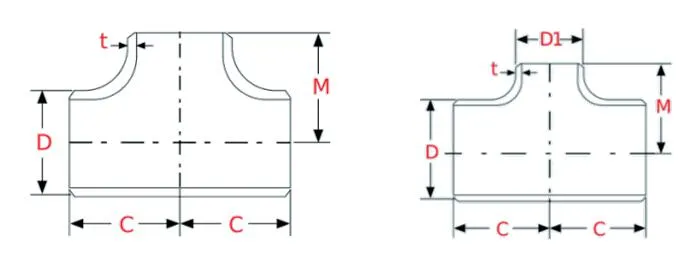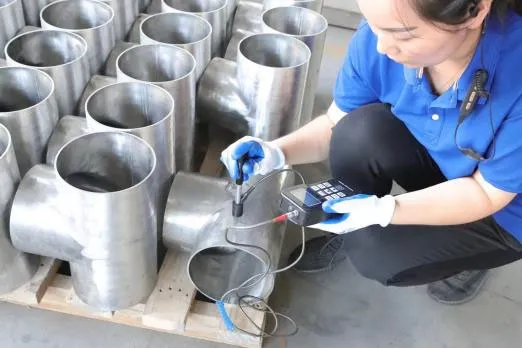
Titanium Tees are pipe fittings designed to connect three pipeline sections, allowing fluid to branch or converge. Manufactured from high-grade titanium materials such as Grade 2 titanium, Grade 7 titanium, or Grade 12 titanium, these titanium pipe fittings offer excellent corrosion resistance, high strength-to-weight ratio, and durability under extreme conditions.
Available in equal (straight) tees and reducing tees, titanium tees are widely used in chemical processing, marine systems, and high-purity or acidic fluid applications.
Titanium equal tee-used when all branches have the same diameter
Titanium reducing tee-ideal for connecting pipes of different diameters

These titanium butt weld tee fittings conform to international standards such as ASTM B363, ASME B16.9, and are available in various sizes and wall thicknesses to suit customized piping systems, like titanium heat exchangers, condensers and evaporators.
Due to their outstanding properties, titanium tees are extensively used in:
1. Chemical processing piping systems
2. Seawater desalination and marine engineering
3. Aerospace and defense fluid lines
4. Nuclear power plants
5. Heat exchanger piping solutions
Titanium tees are produced using two main manufacturing methods: seamless forming and welded fabrication, depending on the size, material grade, and application requirements.
1. Seamless Titanium Tee Process
Seamless titanium tees are manufactured from a single piece of seamless titanium pipe.
The main processes include:
Hot extrusion: The base pipe is heated and extruded through a mold to form the tee branch.
Hydraulic bulging: The pipe is placed into a mold and pressurized internally to form the branch outlet.
Die forging and machining: Forged from titanium billets and then precisely machined to size.
Features:
No welds, high structural integrity.
Excellent corrosion resistance.
Suitable for high-purity and high-pressure applications.
Generally limited to smaller sizes (up to DN100 or 4").
2. Welded Titanium Tee Process
Welded tees are fabricated by assembling titanium pipes or plates and joining them through welding. The typical steps include:
Cutting & forming: Titanium pipes or plates are cut and shaped into required segments.
Welding: Parts are joined using TIG (GTAW) welding, ensuring proper penetration and fusion.
Post-weld heat treatment: Stress relief and structural optimization.
Surface treatment: Pickling, passivation, or polishing depending on application.
Non-destructive testing: Radiographic or ultrasonic inspection of welds to ensure quality.
Features:
Suitable for large diameters and special dimensions.
More economical and flexible for custom fabrication.
Requires strict weld quality control.
To ensure their quality and compliance with international standards, a comprehensive inspection process is required.
1. Visual Inspection
Check for surface defects: cracks, dents, pits, scratches, or surface contamination.
Ensure the absence of burrs, sharp edges, or welding splatter (if welded).
Confirm that the forming is uniform and the shape conforms to tee geometry.
2.Dimensional Inspection
Measure key dimensions: Outside Diameter (main run and branch), Wall Thickness, Center-to-End Lengths, Overall Length, Out-of-roundness and straightness.
Verify tolerances according to:
ASME B16.9 (for seamless tees)
ASTM B363 (for titanium welded/seamless fittings)
Custom drawings, if applicable
Tools used: Vernier calipers, micrometers, angle gauges, and CMM (Coordinate Measuring Machine) if required.
3.Material Testing
PMI (Positive Material Identification): Verify that the material is the correct titanium grade (e.g., Gr.2 or Gr.5), using XRF or optical emission spectroscopy.
Chemical Composition: Cross-check mill test certificate (MTC) with laboratory test if needed (per ASTM E2371 or ASTM E539).
4.Nondestructive Testing (NDT)
Ultrasonic Testing (UT); Radiographic Testing (RT); Dye Penetrant Testing (PT)
5.Documentation Review
MTC and related report

Titanium Tees are packaged to ensure safety, cleanliness, and resistance to corrosion during transport and storage.
Inner Packaging:
Wrapped in plastic film or sealed PE bags
End caps on each outlet to prevent contamination
Outer Packaging:
Placed in export-grade plywood cases with foam lining
Each piece separated with foam or cardboard to prevent surface contact
Marking:
Labeled with grade, size, heat number, and order ID